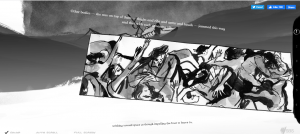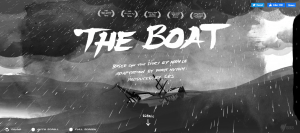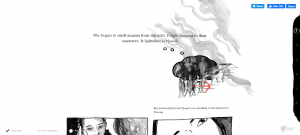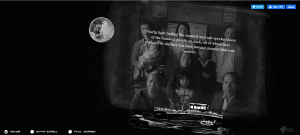The Boat (2015) is an enhanced book that focuses on a non-fiction story about Vietnamese asylum seekers during the venture from their homeland to Australia. It is a harsh and intense story that explores the backstory of the characters Quyen and Mai, as well as the impact that fellow Vietnamese refugees experienced when fleeing their country. This enhanced book is free and easily accessible from the Australian Special Broadcasting Service (SBS) website with readers recommended to be fifteen years or older. The book incorporates a range of animated painting styles to display the full narrative. This art style also uses audio to make the story even more intense and captivate the audience with individual character moments and display of emotions.
The enhance book is split up into six chapters with an auto-scroll website feature that the reader can control by clicking the button at the bottom of the screen. This allows the reader to view the artworks and written text at their own pace while viewing the book. Having a table of contents for the chapter numbers allows the reader to navigate this enhanced book with ease (Browne & Coe, 2012, p. 290). The reader can choose to stop reading if they want to and come back to it by clicking on the chapter numbers on the right side of the website. This also means that the reader can navigate the book with a click of each chapter button to continue this reading experience.
In certain parts of the story there are also elements of interactive arrows that appear next to thought bubble photos that are often found in graphic novels. This ensures that the reader can interpret and use these multimedia arrows and their personal digital skills to fully understand how to access this part of the narrative (Jimenez & Meyer, 2016, p. 426). Each of these arrows provides further information about that character’s backstory and what they are thinking in that situation. This backstory establishes stronger connections to the characters and allows the reader to delve deeper into the storyline.
This enhanced book is displayed like a movie credit as the scrolling feature makes it seem like one continuous roll of film that is playing in front of the reader’s eyes. The book could be further adapted by including old footage of historical situations like this narrative. Providing the backstory for some these characters distinguishes the emotions they are feeling and contrasts what has been left behind. Having this option to view old footage would ensure that the audience has a variety of examples to refer to when researching further on a topic about refugees.

During certain sections of the book, the art style changes according to the situation. This means that instead of the simple left to right reading of written text, there are occasions when the text is completely turned on its side or spread out in single words. This use of image and text in this enhanced book is incredibly similar to graphic novels, which encourages the reader to view the story in multiple ways. With continual changes in 21st century technologies, readers will be able to gather information from this type of narrative and evaluate what the author is trying to say based on this style of literature (Moorefield-Lang & Gavigan, 2012, p. 32). The written text can change significantly too, being presented like a printed novel and then changing back to single phrases using speech bubbles.

The quality of this enhanced book is fantastic as it provides multiple perspectives from the characters throughout each chapter. The animation style corresponds significantly to the actions occurring in the narrative. The reader’s attention is continually focused on the thoughts of the character but provides audio to make a more impactful emotional response from the reader as you care what happens to them. For example, as the boat rocks to one side you get a sense of worry that something horrible is going to happen. This means that so much of the narrative relies on the animation style to encourage the reader to continue scrolling through each chapter.
The intrinsic motivation behind this story encourages the reader to use their personal graphic novel reading skills to fully understand what is happening. This means that readers must distinguish how the character moves and thinks in each panel and throughout all the corresponding print. McClanahan & Nottingham (2019) encourage that readers of graphic novels need to acknowledge the correct way to interpret information and storylines based on the visual literacy contained in a storyline. Having this personal interpretation allows the reader to develop more motivation to finish the story as they discover what this experience would be like for refugees.
References
Browne, G., & Coe, M. (2012). Ebook navigation: Browse, search and index. Australian Library Journal, 61(4), 288-297. Retrieved from https://ezproxy.csu.edu.au/login?url=https://search-proquest-com.ezproxy.csu.edu.au/docview/1242448210?accountid=10344
Huynh, M. (2015). The Boat. Special Broadcasting Service (SBS) Australia. Retrieved from http://www.sbs.com.au/theboat/
Jimenez, L. M., & Meyer, C. K. (2016). First impressions matter: Navigating graphic novels utilizing linguistic, visual, and spatial awareness. Journal of Literacy Research, 48(4), 423-447. DOI: 10.1177/1086296X16677955
McClanahan, B. J., & Nottingham, M. (2019). A suite of strategies for navigating graphic novels: A dual coding approach. International Literacy Association, 73(1), 39-50. Retrieved from https://doi-org.ezproxy.csu.edu.au/10.1002/trtr.1797
Moorefield-Lang, H., & Gavigan, K. (2012). These aren’t your father’s funny papers: The new world of digital graphic novels. Knowledge Quest, 40(3), 30-35. Retrieved from https://ezproxy.csu.edu.au/login?url=https://search-proquest-com.ezproxy.csu.edu.au/docview/1016285025?accountid=10344



No Comments